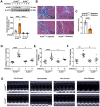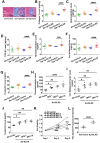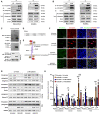A novel role of kallikrein-related peptidase 8 in the pathogenesis of diabetic cardiac fibrosis
- PMID: 33754057
- PMCID: PMC7977470
- DOI: 10.7150/thno.48530
A novel role of kallikrein-related peptidase 8 in the pathogenesis of diabetic cardiac fibrosis
Abstract
Rationale: Among all the diabetic complications, diabetic cardiomyopathy, which is characterized by myocyte loss and myocardial fibrosis, is the leading cause of mortality and morbidity in diabetic patients. Tissue kallikrein-related peptidases (KLKs) are secreted serine proteases, that have distinct and overlapping roles in the pathogenesis of cardiovascular diseases. However, whether KLKs are involved in the development of diabetic cardiomyopathy remains unknown.The present study aimed to determine the role of a specific KLK in the initiation of endothelial-to-mesenchymal transition (EndMT) during the pathogenesis of diabetic cardiomyopathy. Methods and Results-By screening gene expression profiles of KLKs, it was found that KLK8 was highly induced in the myocardium of mice with streptozotocin-induced diabetes. KLK8 deficiency attenuated diabetic cardiac fibrosis, and rescued the impaired cardiac function in diabetic mice. Small interfering RNA (siRNA)-mediated KLK8 knockdown significantly attenuated high glucose-induced endothelial damage and EndMT in human coronary artery endothelial cells (HCAECs). Diabetes-induced endothelial injury and cardiac EndMT were significantly alleviated in KLK8-deficient mice. In addition, transgenic overexpression of KLK8 led to interstitial and perivascular cardiac fibrosis, endothelial injury and EndMT in the heart. Adenovirus-mediated overexpression of KLK8 (Ad-KLK8) resulted in increases in endothelial cell damage, permeability and transforming growth factor (TGF)-β1 release in HCAECs. KLK8 overexpression also induced EndMT in HCAECs, which was alleviated by a TGF-β1-neutralizing antibody. A specificity protein-1 (Sp-1) consensus site was identified in the human KLK8 promoter and was found to mediate the high glucose-induced KLK8 expression. Mechanistically, it was identified that the vascular endothelial (VE)-cadherin/plakoglobin complex may associate with KLK8 in HCAECs. KLK8 cleaved the VE-cadherin extracellular domain, thus promoting plakoglobin nuclear translocation. Plakoglobin was required for KLK8-induced EndMT by cooperating with p53. KLK8 overexpression led to plakoglobin-dependent association of p53 with hypoxia inducible factor (HIF)-1α, which further enhanced the transactivation effect of HIF-1α on the TGF-β1 promoter. KLK8 also induced the binding of p53 with Smad3, subsequently promoting pro-EndMT reprogramming via the TGF-β1/Smad signaling pathway in HCAECs. The in vitro and in vivo findings further demonstrated that high glucose may promote plakoglobin-dependent cooperation of p53 with HIF-1α and Smad3, subsequently increasing the expression of TGF-β1 and the pro-EndMT target genes of the TGF-β1/Smad signaling pathway in a KLK8-dependent manner. Conclusions: The present findings uncovered a novel pro-EndMT mechanism during the pathogenesis of diabetic cardiac fibrosis via the upregulation of KLK8, and may contribute to the development of future KLK8-based therapeutic strategies for diabetic cardiomyopathy.
Keywords: KLK8; cardiac fibrosis; diabetic cardiomyopathy; endothelial-to-mesenchymal transition; plakoglobin.
© The author(s).
Conflict of interest statement
Competing Interests: The authors have declared that no competing interest exists.
Figures











Similar articles
-
TGF-β1-induced SMAD2/3/4 activation promotes RELM-β transcription to modulate the endothelium-mesenchymal transition in human endothelial cells.Int J Biochem Cell Biol. 2018 Dec;105:52-60. doi: 10.1016/j.biocel.2018.08.005. Epub 2018 Aug 16. Int J Biochem Cell Biol. 2018. PMID: 30120989
-
miR-222 inhibits cardiac fibrosis in diabetic mice heart via regulating Wnt/β-catenin-mediated endothelium to mesenchymal transition.J Cell Physiol. 2020 Mar;235(3):2149-2160. doi: 10.1002/jcp.29119. Epub 2019 Aug 6. J Cell Physiol. 2020. PMID: 31389030
-
Apolipoprotein A1 Inhibits the TGF-β1-Induced Endothelial-to-Mesenchymal Transition of Human Coronary Artery Endothelial Cells.Cardiology. 2017;137(3):179-187. doi: 10.1159/000464321. Epub 2017 Apr 22. Cardiology. 2017. PMID: 28434000
-
Transcriptional regulation of endothelial-to-mesenchymal transition in cardiac fibrosis: role of myocardin-related transcription factor A and activating transcription factor 3.Can J Physiol Pharmacol. 2017 Oct;95(10):1263-1270. doi: 10.1139/cjpp-2016-0634. Epub 2017 Jul 7. Can J Physiol Pharmacol. 2017. PMID: 28686848 Review.
-
MicroRNAs in kidney fibrosis and diabetic nephropathy: roles on EMT and EndMT.Biomed Res Int. 2013;2013:125469. doi: 10.1155/2013/125469. Epub 2013 Sep 8. Biomed Res Int. 2013. PMID: 24089659 Free PMC article. Review.
Cited by
-
Endothelial-Mesenchymal Transition and Possible Role of Cytokines in Streptozotocin-Induced Diabetic Heart.Biomedicines. 2025 May 9;13(5):1148. doi: 10.3390/biomedicines13051148. Biomedicines. 2025. PMID: 40426976 Free PMC article.
-
Upregulation of KLK8 Predicts Poor Prognosis in Pancreatic Cancer.Front Oncol. 2021 Jul 30;11:624837. doi: 10.3389/fonc.2021.624837. eCollection 2021. Front Oncol. 2021. PMID: 34395235 Free PMC article.
-
Fibroblast Upregulation of Vitamin D Receptor Represents a Self-Protective Response to Limit Fibroblast Proliferation and Activation during Pulmonary Fibrosis.Antioxidants (Basel). 2023 Aug 18;12(8):1634. doi: 10.3390/antiox12081634. Antioxidants (Basel). 2023. PMID: 37627629 Free PMC article.
-
Mangiferin alleviates diabetic pulmonary fibrosis in mice via inhibiting endothelial-mesenchymal transition through AMPK/FoxO3/SIRT3 axis.Acta Pharmacol Sin. 2024 May;45(5):1002-1018. doi: 10.1038/s41401-023-01202-7. Epub 2024 Jan 15. Acta Pharmacol Sin. 2024. PMID: 38225395 Free PMC article.
-
The role of myocardial fibrosis in the diabetic cardiomyopathy.Diabetol Metab Syndr. 2025 Jun 24;17(1):242. doi: 10.1186/s13098-025-01783-9. Diabetol Metab Syndr. 2025. PMID: 40551185 Free PMC article. Review.
References
-
- Zheng Y, Ley SH, Hu FB. Global aetiology and epidemiology of type 2 diabetes mellitus and its complications. Nat Rev Endocrinol. 2018;14:88–98. - PubMed
-
- Prattichizzo F, Matacchione G, Giuliani A, Sabbatinelli J, Olivieri F, de Candia P. et al. Extracellular vesicle-shuttled miRNAs: a critical appraisal of their potential as nano-diagnostics and nano-therapeutics in type 2 diabetes mellitus and its cardiovascular complications. Theranostics. 2021;11:1031–45. - PMC - PubMed
Publication types
MeSH terms
Substances
LinkOut - more resources
Full Text Sources
Other Literature Sources
Molecular Biology Databases
Research Materials
Miscellaneous

